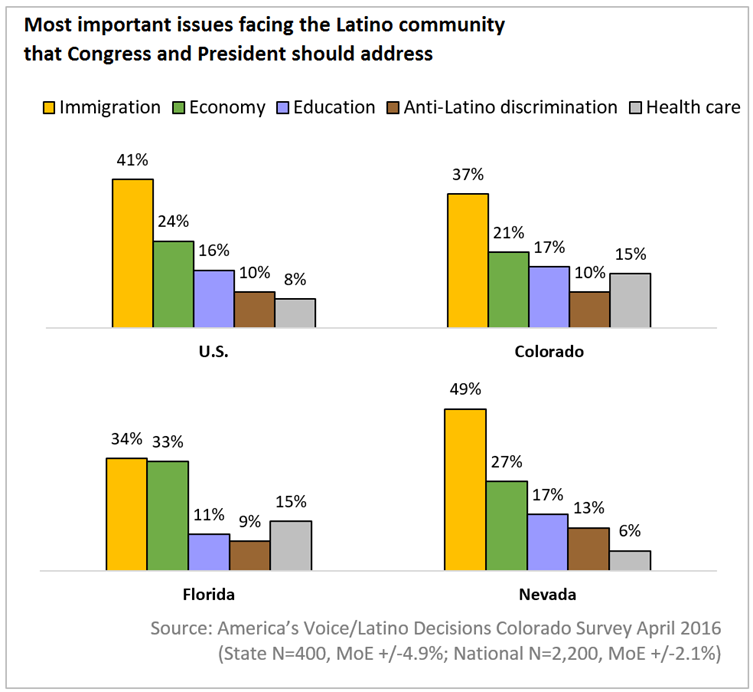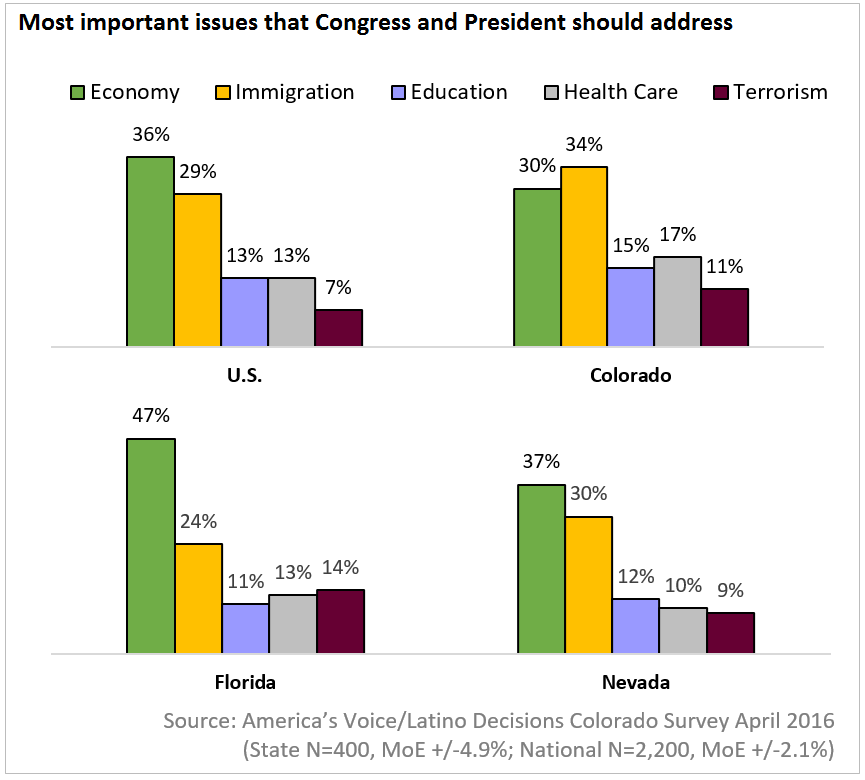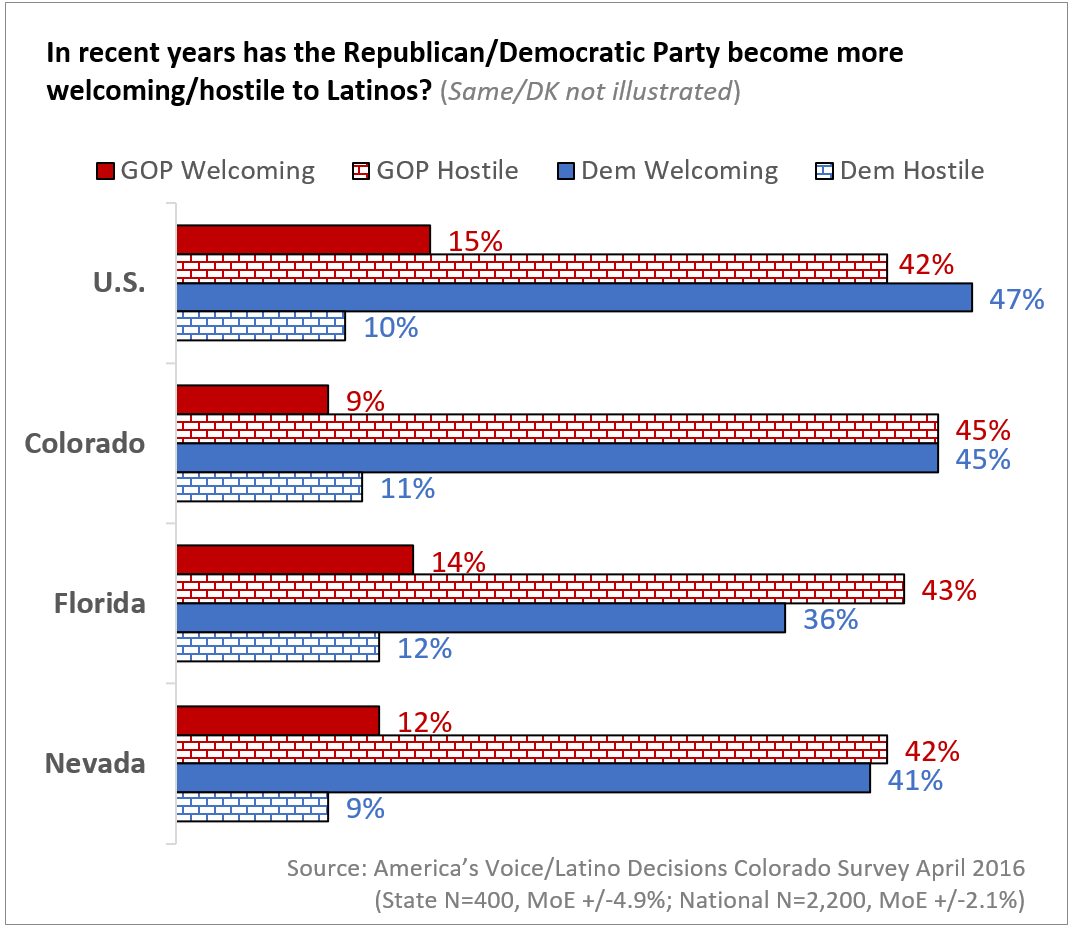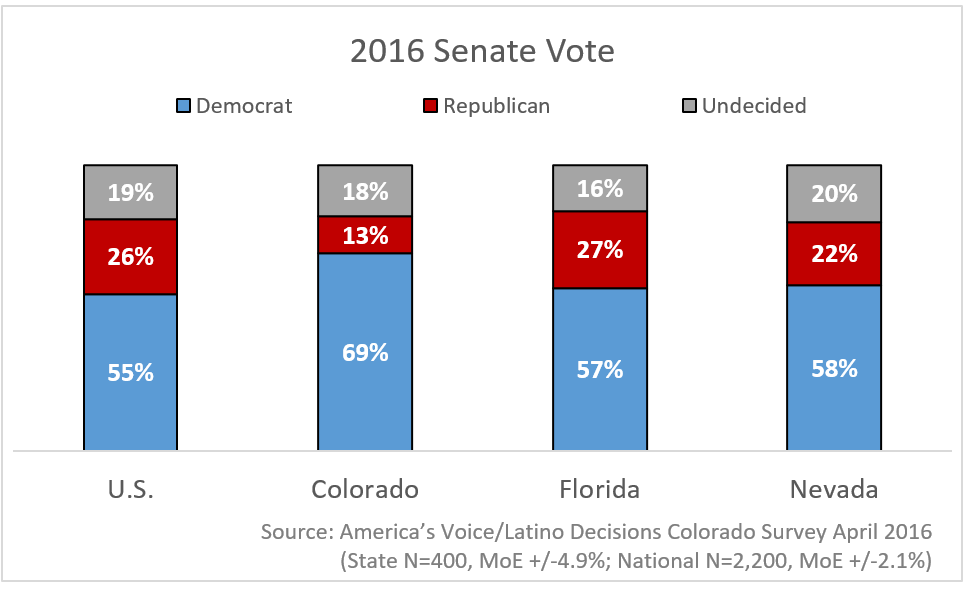Yesterday, America’s Voice and Latino Decisions released the first of three waves of national polling of the 2016 Latino electorate (toplines here, crosstabs here, slide deck here). The national results suggest that for most Latino voters, immigration and anti-Latino discrimination are the most important issue facing the Latino community. The poll also reveals how the parties and their presidential candidates’ handling of immigration — particularly the Democrats’ support for and the Republicans opposition to DACA and DAPA — is making it virtually impossible for the GOP to make in-roads with Latino voters in 2016. The poll results also suggest that Donald Trump is the main driver of increased enthusiasm for voting in 2016 among Latino voters.
While national data are helpful for understanding the broad contours of how immigration politics and policy are likely to matter next November, the uneven distribution of Latino voters across the states means that these effects can be either more-or-less pronounced depending upon the size of the Latino electorate and the competitiveness of the electoral context.
To that end, today America’s Voice and Latino Decisions released poll results from three states with large Latino populations and where Latino voters have been deterministic in recent election cycles: Colorado, Florida, and Nevada. Not only did Barack Obama win these states in both 2008 and 2012 (after all three were carried by George W. Bush in 2000 and 2004), all three states will feature competitive U.S. Senate and House elections in 2016. In Florida and Nevada, the Senate races will be for open seats.
Colorado Results: Toplines, Crosstabs, Deck
Florida Results: Toplines, Crosstabs, Deck
Nevada Results: Toplines, Crosstabs, Deck
In each state, 400 registered Latino voters were polled using bilingual interviewers and a mix of land, cell, and web-based interviews. The poll’s margin of error is +/- 4.9 percentage points. The poll was designed to assess how immigration policy and politics are shaping the political environment for Latino voters in three critical swing states moving into the 2016 election. In addition to the results discussed below, the polling includes:
- Favorable and unfavorable ratings for the presidential candidates
- Summaries of head-to-head match ups between the Democratic presidential candidates (Hillary Clinton and Bernie Sanders) against their Republican counterparts (Donald Trump and Ted Cruz).
- Scales measuring the degree to which the presidential candidates are viewed as pro- or anti-immigrant or immigration
- Questions gauging how the presidential candidates’ views towards immigrants and immigration are likely to impact vote choice in the fall
- Assessments of how Latino voters are responding to specific polices being discussed by the presidential candidates (e.g., DACA, DAPA, self-deportation, and deportation forces)
- Evaluations of the personal attachments that Latino voters have to undocumented immigrants, including DACA applicants
First and foremost, the state polls indicate that immigration politics and policy are front-and-center for most Latino voters as they consider the 2016 election. As the data below summarize, when half of the sample was asked what is the most important issue facing the Latino community, immigration is the top priority nationally and across all three states, followed by the economy and jobs. Also note the share of Latino voters nationally and in each state offering anti-Latino discrimination as the most important issue. As is detailed below, this reaction is almost exclusively in response to the Republican Party and the rhetoric of its presidential front-runner, Donald Trump.

The second figure details the responses to the most important issue question when the prompt “facing the Latino community” is included. This question was asked to half of respondents and suggests that there is some differentiation in how Latinos see the issue environment with respect to their community and as compared to the country in general. Specifically, immigration and anti-Latino discrimination decrease in importance while jobs and the economy increases. However, given the larger margins of errors for the split-sample, most of these differences for the state samples are not statistically significant. Still, the pattern is consistent both nationally and across the three states.

The results also indicate that Latino voters’ perceptions of the two parties are moving in opposite directions. The following figures detail responses to a split-sample question asking if the Democratic Party is seen as truly caring about the Latino community by roughly half of all Latino voters nationally and in Colorado, Florida, and Nevada. In contrast, strong majorities view the Republican Party as either not caring or hostile towards the Latino community.

Moreover, as the data presented below indicate these perceptions are getting hardening. Specifically, the figure summarizes the responses to split-sample question asking if in recent year the parties have become more welcoming, more hostile, or unchanged towards the Latino community.

The poll also leaves little doubt that much of the GOP hostility is being driven by the party’s presidential frontrunner. To be sure, the polling results suggest that Ted Cruz’s call for self-deportation is nearly as problematic for the party’s prospects of cutting its margins with Latino voters as Trump’s pledge to mobilize deportation forces. However, when respondents were asked if they were more enthusiastic about voting in 2016 as compared to 2012, close to half of all respondents nationally and in the three states surveyed indicated that they were more enthusiastic about voting in 2016. Moreover, as the data in the figure below details, stopping Donald Trump is the primary reason offered by these voters for why they are more enthusiastic about voting in this cycle.

In addition to assessing how immigration politics and policy are affecting Latino voters’ perceptions of the presidential election, the polling also assesses vote choice in House and Senate races nationally and in Colorado, Florida, and Nevada. As the figure below details, in all of these races, the Democratic candidates are better positioned. At the same time, except for Nevada, where the likely Senate candidates are known (Democrat Catherine Cortez Masto and Republican Joe Heck) and the candidates’ names were used in the questions, these data report the responses to generic partisan questions. With that said, in Nevada, Cortez Masto is running behind Clinton and Sanders, as well as generic House Democrats. Some of this difference in support may stem from the fact that Heck has represented parts of Clark County (Las Vegas), which is home to roughly 80% of the state’s Latino population and nearly three out of four Nevadans, in the House of Representatives.

Still, these early numbers echo two recent Senate races. In 2012 in Nevada, Democrat Shelly Berkley lost to Republican Dean Heller by just over one percentage point even as Barack Obama carried the state by nearly seven points. Polling for America’s Voice by Latino Decisions throughout 2012 found that Berkley was consistently running behind Obama among Nevada Latinos and in the end, this deficit in support among Latinos relative to Obama might have made the difference in the Senate race.
In Colorado in 2014, Democratic incumbent Senator Mark Udall lost to Cory Gardner by less then two points. The 2014 Latino Decisions Election Eve Poll found that 48% of Colorado Latino voters did not know that Udall supported comprehensive immigration reform including a pathway to citizenship and 41% did not know that Gardner opposed such legislation. If the Udall campaign had been able to draw this contrast more clearly for the Latino electorate, it is unlikely that Gardner would have received 23% of the Latino vote. Given that Cortez Masto supports DACA and DAPA and Heck opposes these policies (Heck also favors revisiting “birth-right citizenship”), ensuring that Latino voters understand these differences and way they mean for their families and communities is paramount. A particularly useful strategy would be linking Heck to Donald Trump. When voters were told that Heck will support whoever the Republican presidential candidate is and that this is likely to be Donald Trump, 70% of respondents reported that this made them somewhat or much less likely to vote for Heck, while 14% indicated this would make them somewhat or much more likely to for Heck; a net difference of 56 points.
In sum, the first round of polling of Latino voters both nationally and in three key swing states details the saliency of immigration policy and politics to the Latino electorate. The poll also demonstrates how Latino voters are responding to the parties’ handling of immigration and the degree to which these views are being shaped by the Republican presidential front-runner Donald Trump. As the 2016 campaign progresses and voters become more engaged in the process, subsequent waves of polling from this project will allow us to gauge how strongly these perceptions are entrenched.
David Damore is a Senior Analyst at Latino Decisions. He is Associate Professor of Political Science at the University of Nevada, Las Vegas, and a Senior Nonresident Fellow in the Brookings Institution’s Governance Studies Program.


